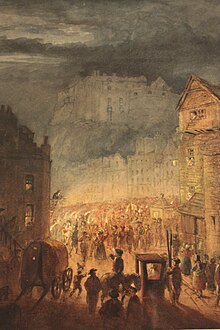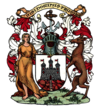Porteous Riots
This article includes a list of general references, but it remains largely unverified because it lacks sufficient corresponding inline citations. (May 2018) |


The Porteous Riots surrounded the activities of Captain John Porteous (c. 1695 – 1736), Captain of the City Guard of Edinburgh, Scotland, who was lynched by a mob for his part in the killing of innocent civilians while ordering the men under his command to quell a disturbance during a public hanging in the Grassmarket, Edinburgh in April 1736. Although the rioters were generally supportive of the convicted smugglers, Porteous seems to have been a somewhat overbearing official, despised by the mob and the underclasses of Edinburgh society.
The riot[]

On 14 April 1736 three convicted smugglers, Andrew Wilson a "notorious smuggler", William Hall and George Robertson, were arrested, tried and condemned to death. Hall's sentence was commuted to exile, while Wilson and Robertson awaited their fate. A few days before the execution they made an escape attempt from the Tolbooth prison (next to St Giles Cathedral) . Wilson removed a bar from the window but became stuck in the window "being a very stout man" and blocked Robertson's escape.[1][2]
Andrew Wilson and Robertson were publicly hanged in the on 14 April 1736. The body of Wilson was cut down by a sailor who ran forward. Captain Porteous reacted to this by grabbing a musket and firing, killing a man in the crowd behind. He ordered his guards to fire on the justifiably angry crowd and a further five were killed. In the ensuing riot the hangman, Porteous and the guards sought refuge in the City Guardhouse on the Royal Mile As the situation worsened, the Lord Provost of Edinburgh, for fear of an attempt to pull the killers out of the guardhouse, instructed Captain Porteous to call out the entire guard and to furnish them with powder and shot.
Accounts of events are confused, but what is certain is that Captain Porteous instructed his men to fire above the heads of the crowd but, in so doing, they shot and wounded people in the windows of the high tenement buildings opposite. The crowd became increasingly violent and, as panic set in, Captain Porteous ordered the guard to shoot into the mob, which led to the deaths of six people in all.
The trial and appeal[]
Porteous was arrested the same afternoon and charged with murder. He was tried at the High Court of Justiciary on 5 July 1736, where a majority of witnesses testified that Porteous had personally fired into the crowd on 14 April, although sixteen others said they had not seen him do so.
Feelings were running high in Edinburgh and the jury unanimously found Porteous guilty of murder. He was sentenced to death, the execution set to take place in the Grassmarket on 8 September 1736. Porteous was imprisoned in the same condemned cell in the Tolbooth as had earlier held Wilson and Robertson.
Events in Scotland alarmed the government in London, and Sir Robert Walpole attempted to influence events by asking his representative in Edinburgh to become involved. But he had miscalculated, underestimating the depth of feeling in Scotland. A formal appeal was petitioned and the execution was deferred.
Death of Porteous[]

Public resentment at a reprieve granted by Queen Caroline was such that a plot to lynch Captain Porteous was hatched, and when the authorities heard of this it was decided to increase the guard at the Tolbooth prison. However, on the evening before this was due to happen, a large crowd of over four thousand gathered at Portsburgh, west of the city.
Making their way across the Grassmarket to the Cowgate and up to the High Street, the mob converged on the Tolbooth, where they were eventually able to overpower the guards. Porteous was dragged from his cell up the Lawnmarket to the West Bow and down to the Grassmarket, where he was lynched from a dyer's pole, using a rope taken from a local draper's shop.
After a short while he was dragged down and stripped of his nightgown and shirt, which was then wrapped around his head before he was hauled up again. However, the mob had not tied his hands and, as he struggled free, they broke his arm and shoulder, while another attempted to set light to his naked foot. He was taken down a further time and cruelly beaten before being hung up again, and died a short while later, just before midnight on 7 September 1736. He was buried in Greyfriars Kirkyard, Edinburgh, the following day.
Aftermath[]

The events in Edinburgh heightened the sense of alarm in London, where the government was concerned about the threat to its management of Scotland. It was thought by Walpole, Queen Caroline and the Duke of Newcastle that Porteous had been unnecessarily sacrificed and there were even rumours that the conspiracy had involved the local city magistrates.
In February 1737 a parliamentary inquiry was held; the House of Lords initially proposed the disbanding of the town guard and removal of Netherbow Port, but subsequently dropped these suggestions. Eventually the only punishments enforced were a £2,000 fine imposed on the city (used to support Porteous' widow) and the disbarment from all offices of the then Lord Provost Alexander Wilson.[3]
It was variously thought that Porteous' murder was carried out by friends of those who had been shot and killed, revenge by the smugglers, a Jacobite plot, or even a conspiracy by Presbyterian extremists. However, the organisation of events seems to imply a degree of planning, thought to be the work of James Maxwell, an Edinburgh journeyman carpenter, together with a small group of city tradesmen and journeymen.
However, despite a reward of £200 being made available by the government for information, those responsible for the murder of Porteous were never found.
The events surrounding the Porteous Riots form part of the early chapters of the novel The Heart of Midlothian by Sir Walter Scott (1818), where they are recorded in graphic detail.
Memorials[]

The final resting place of John Porteous in Greyfriars Kirkyard had for more than two hundred years been marked by a small square stone engraved with the single letter "P" and the date 1736. More recently, this has been replaced with a headstone of Craigleith stone, bearing the inscription "John Porteous, a captain of the City Guard of Edinburgh, murdered September 7, 1736. All Passion Spent, 1973."
The spot where Porteous died in the Grassmarket is today marked by a memorial plate. The site of the notorious Tolbooth prison is marked by paving stones arranged in the form of a heart, known as the Heart of Midlothian. Even today, passers-by will spit on the spot, a tradition originally intended to demonstrate their contempt for the hated Tolbooth.
See also[]
- John Porteous (soldier)
- Porteous family
- The Heart of Mid-Lothian (work by Sir Walter Scott)
References[]
- Scott, Sir Walter.The Heart of Mid-Lothian, (1818)
- The Encyclopædia Britannica (1911)
- Lever, Sir Tresham. Sir Walter Scott and the Murder of Porteous (1971)
- Porteous, Barry. The Porteous Story, (Porteous Associates, 1975)
- K.J. Logue. John Porteous in Oxford Dictionary of National Biography (Oxford: University Press, 2005)
- 1736 riots
- 1736 in Scotland
- History of Edinburgh
- Riots and civil disorder in Scotland
- Old Town, Edinburgh
- 18th century in Edinburgh


